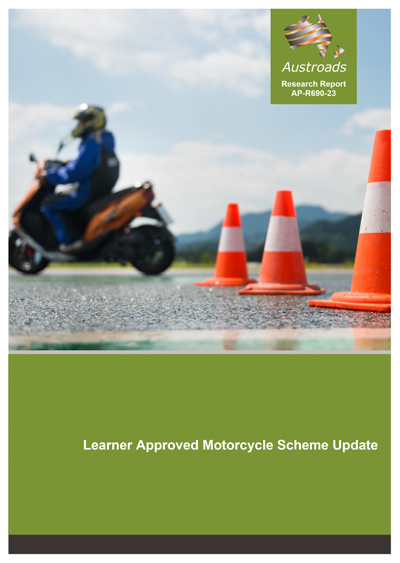Road Safety

- Publication no: AP-R690-23
- ISBN: 978-1-922700-97-1
- Published: 13 June 2023
- PDF (free) Download
The current Learner Approved Motorcycle Scheme (LAMS) was introduced in NSW in 2002 and has since been adopted by all states, territories, and New Zealand, albeit with some amendments in some jurisdictions. There has not been a formal review of LAMS to date.
This report documents the project that reviewed the current LAMS with the aim of bringing it up to date with latest research and information. Specifically, the review focusses on whether certain types of motorcycles are more likely to be involved in Fatal and Serious Injury (FSI) crashes and are difficult to ride thus should be removed from LAMS, whether ACT’s LAMS should be adopted by other jurisdictions, whether electric motorcycles with a 25 kW motor or greater should be added to the LAMS, assessing the feasibility of allowing more motor trikes to the LAMS, assessing the feasibility of allowing physical disability modifications to LAMS motorcycles; and assessing whether safety modifications should be permitted on LAMS motorcycles. Further, back cast modelling was performed to understand the benefits of Antilock Braking System (ABS), Traction Control System (TCS), and a lower Power-to-Weight Ratio (PWR) on novice FSI crashes. Three workshops with stakeholders were also held to obtain their input.
The recommendations from this project are:
- To not remove any type of motorcycles from the LAMS list until further research is performed.
- To not adopt ACT LAMS until further research is performed.
- Allow all motor trikes to be added to the LAMS provided that they meet the current LAMS criteria.
- Allow modifications for accessibility provided that the motorcycles comply with LAMS criteria and relevant standards and legislation.
- Allow modifications to improve safety and functionality provided that the motorcycles comply with LAMS criteria and relevant standards and legislation.
- Consider encouraging a faster update of ABS and TCS for LAMS or mandating ABS and TCS for LAMS.
- Summary
- 1. Introduction
- 1.1 Purpose
- 1.2 Scope
- 2. MUARC Report Review
- 3. Literature Review
- 3.1 Current LAMS Practices in Australia and New Zealand and Equivalent Schemes Overseas.
- 3.1.1 Current LAMS in Australia and New Zealand
- 3.1.2 Novice Motorcycle Schemes in the UK, The Netherlands, Sweden, and Canada.
- 3.2 Assessing the Feasibility of Adopting ACT’s LAMS
- 3.3 Assessing the Feasibility of Including Electric Motorcycles with a 25 kW or Greater Motor in LAMS
- 3.4 Assessing the Feasibility of Including More Motor Trikes in the LAMS
- 3.5 Assessing the Feasibility of Allowing Modifications to LAMS Motorcycles for Accessibility
- 3.6 Assessing the Feasibility of Allowing Modifications to LAMS Motorcycles to Improve Safety
- 3.7 Understanding Whether Some Types of Motorcycles on the LAMS are More Difficult to Ride
- 3.7.1 Key Parameters Affecting Motorcycle Dynamic Stability and Operator Manoeuvrability
- 3.7.2 Motorcycle Type and Ease of Riding
- 3.7.3 Conclusions on Motorcycle Type and Ease of Riding
- 3.7.4 Recommendation
- 3.1 Current LAMS Practices in Australia and New Zealand and Equivalent Schemes Overseas.
- 4. Back Casting Modelling
- 4.1 Data Used in and Information Applied to the Back Casting Model
- 4.2 Back Casting Model Results
- 4.2.1 Effect of ABS on LAMS Crash Rates
4.2.2 Effect of ABS + TCS on LAMS Crash Rates - 4.2.3 Graphs of ABS and, ABS + TCS Effectiveness Overlaid
- 4.2.4 Effectiveness of ABS + TCS + lower PWR limit
- 4.2.1 Effect of ABS on LAMS Crash Rates
- 4.3 Back Cast Modelling Conclusions
- 4.4 Benefit Cost Ratios
- 4.4.1 Benefit Cost Ratio for ABS
- 4.4.2 Benefit Cost Ratio for TCS
- 4.4.3 Conclusions with Consideration of BCR
- 4.5 Stakeholder Workshops
- 4.5.1 Research Organisations and State Government Insurance Organisations Workshop Feedback
- 4.5.2 Motorcycle Industry Workshop
- 4.5.3 Motorcycle Rider Organisation Representative Workshop
- 5. Summary of Project Recommendations and Future Works Recommendations
- 5.1 Summary of Project Recommendations
- References
- Appendix A Literature Review Methodology Notes
- Appendix B Back Cast Modelling Results Tables
- Appendix C Workshop Minutes
